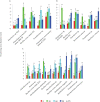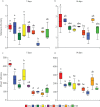Root exudates and chemotactic strains mediate bacterial community assembly in the rhizosphere soil of Casuarina equisetifolia L
- PMID: 36212345
- PMCID: PMC9534574
- DOI: 10.3389/fpls.2022.988442
Root exudates and chemotactic strains mediate bacterial community assembly in the rhizosphere soil of Casuarina equisetifolia L
Abstract
Rhizosphere bacterial diversity and community structure are important factors involving in plant growth. However, the exact process of how plant rhizosphere bacterial community structures is assembled remains unclear. To investigate the role of bacterial chemotaxis to rhizosphere secretions in the establishment of rhizosphere microbial community in Casuarina equisetifolia, we screened bacteria strains derived from the rhizosphere of Casuarina equisetifolia L. using top three chemicals of the plant root exudates (2,4-di-tert-butylphenol, methyl stearate, and arginine) as chemoattractant. Among 72 bacterial strains, five showed strong chemotaxis to 2,4-di-tert-butylphenol, six to methyl stearate, and eleven to arginine, with the highest bacterial chemotaxis occurring at a concentration of 60 μM. This indicates that arginine is a more important chemoattractant than 2,4-di-tert-butylphenol, methyl stearate in the establishment of rhizosphere microbial community in Casuarina equisetifolia. Bacterial community assembly analysis using different chemoattractants and chemoattractants-plus-bacteria combinations were then performed by burying laboratory prepared bags of sterlized soil into C. equisetifolia forest. Bacteria diversity and enrichment analyses using 16S rDNA sequencing at 7 and 14 days after burying showed that arginine-plus-Ochrobactrum sp. and Pantoea sp. treatment exhibited the greatest similarity to the natural forest bacterial community. Our date provides new insights into how chemoattractants and chemotactic bacteria strains shape the rhizosphere microbial community of C. equisetifolia, which constitutes foundational information for future management of these communities.
Keywords: bacterial diversity; casuarina equisetifolia L.; chemotaxis; hainan; root exudates.
Copyright © 2022 Lin, Li, Wang, Xu and Li.
Conflict of interest statement
The authors declare that the research was conducted in the absence of any commercial or financial relationships that could be construed as a potential conflict of interest.
Figures









Similar articles
-
Is allelochemical synthesis in Casuarina equisetifolia plantation related to litter microorganisms?Front Plant Sci. 2022 Nov 2;13:1022984. doi: 10.3389/fpls.2022.1022984. eCollection 2022. Front Plant Sci. 2022. PMID: 36407626 Free PMC article.
-
Structural variability and niche differentiation of the rhizosphere and endosphere fungal microbiome of Casuarina equisetifolia at different ages.Braz J Microbiol. 2020 Dec;51(4):1873-1884. doi: 10.1007/s42770-020-00337-7. Epub 2020 Jul 13. Braz J Microbiol. 2020. PMID: 32661898 Free PMC article.
-
Ecological niche selection shapes the assembly and diversity of microbial communities in Casuarina equisetifolia L.Front Plant Sci. 2022 Oct 20;13:988485. doi: 10.3389/fpls.2022.988485. eCollection 2022. Front Plant Sci. 2022. PMID: 36340378 Free PMC article.
-
Screening of Casuarina equisetifolia rhizosphere-promoting bacteria and their effects on seed germination and seedling growth.Ying Yong Sheng Tai Xue Bao. 2024 Aug;35(8):2159-2166. doi: 10.13287/j.1001-9332.202408.030. Ying Yong Sheng Tai Xue Bao. 2024. PMID: 39419801 English.
-
Chemotaxis of Beneficial Rhizobacteria to Root Exudates: The First Step towards Root-Microbe Rhizosphere Interactions.Int J Mol Sci. 2021 Jun 22;22(13):6655. doi: 10.3390/ijms22136655. Int J Mol Sci. 2021. PMID: 34206311 Free PMC article. Review.
Cited by
-
Rhizosphere microbiome regulation: Unlocking the potential for plant growth.Curr Res Microb Sci. 2024 Nov 22;8:100322. doi: 10.1016/j.crmicr.2024.100322. eCollection 2025. Curr Res Microb Sci. 2024. PMID: 39678067 Free PMC article. Review.
-
Certain Tomato Root Exudates Induced by Pseudomonas stutzeri NRCB010 Enhance Its Rhizosphere Colonization Capability.Metabolites. 2023 May 16;13(5):664. doi: 10.3390/metabo13050664. Metabolites. 2023. PMID: 37233705 Free PMC article.
-
Development of a chemotactic SynCom bioorganic fertilizer for biocontrol of bacterial wilt in tobacco fields.Appl Microbiol Biotechnol. 2025 Jul 16;109(1):168. doi: 10.1007/s00253-025-13547-6. Appl Microbiol Biotechnol. 2025. PMID: 40670700 Free PMC article.
-
Characterisation of Soil Bacterial Communities That Exhibit Chemotaxis to Root Exudates from Phosphorus-Limited Plants.Microorganisms. 2023 Dec 14;11(12):2984. doi: 10.3390/microorganisms11122984. Microorganisms. 2023. PMID: 38138128 Free PMC article.
-
Is allelochemical synthesis in Casuarina equisetifolia plantation related to litter microorganisms?Front Plant Sci. 2022 Nov 2;13:1022984. doi: 10.3389/fpls.2022.1022984. eCollection 2022. Front Plant Sci. 2022. PMID: 36407626 Free PMC article.
References
-
- Burr T. J., Schroth M. N., Suslow T. (1978). Increased potato yields by treatment of seed pieces with specific strains of Pseudomonas fluorescens and p Putida. Phytopathology 68, 1377–1383. doi: 10.1094/Phyto-68-1377 - DOI
-
- Cai D., Liu S., Tian G., Xu X., Cui D., Zhang J. (2010). Analysis of tourism climate resources in hainan island. Modern Agric. Technol. 18, 20+24. Available at: http://kns.cnki.net/kcms/detail.aspx?FileName=ANHE201016006&DbName=CJFQ2010
LinkOut - more resources
Full Text Sources

